Nanotechnology m hofmann
- 1. Particles:Particles: Nanoparticles, FullerenesNanoparticles, Fullerenes and Carbon Nano Tubesand Carbon Nano Tubes Margarethe HofmannMargarethe Hofmann MAT SEARCH, PullyMAT SEARCH, Pully President SVMTPresident SVMT
- 2. Topics of the WorkshopTopics of the Workshop ´ü« ┬½╠²Environmental Aspects╠²┬╗ ÔÇô latest research┬½╠²Environmental Aspects╠²┬╗ ÔÇô latest research activitiesactivities ´ü« ┬½╠²Material Safety Standards╠²┬╗ - required for┬½╠²Material Safety Standards╠²┬╗ - required for safety of producers and consumerssafety of producers and consumers ´âÿ nearly or insoluble particlesnearly or insoluble particles
- 3. Properties of Nanoparticles (< 100 nm) Zimmermann K arg Cyrys Behrendt/Allessandrini S chulz Peters Wolff Schramm Maier AndraeWittmaa ck Zimmermann K arg Cyrys Behrendt/Allessandrini S chulz Peters Wolff Schramm Maier AndraeWittmaa ck Aerosol formation processes: ÔÇó Heterogeneous + homogeneous nucleationHeterogeneous + homogeneous nucleation ÔÇó Combustion, photochemical reactions; etc.Combustion, photochemical reactions; etc. ÔÇó Growth by coagulation, shrinkageGrowth by coagulation, shrinkage Chemical formation processes: ÔÇó Polymerization (Emulsion) ÔÇó Precipitation, Crystallization ÔÇó Growth by coagulation, shrinkage After: Wolfgang G. Kreyling, GSF ÔÇô Forschungszentrum f├╝r Umwelt und Gesundheit, M├╝nchen
- 4. Current and Emerging Applications for Nanoparticles
- 5. Investors, Industrials, ScientistsInvestors, Industrials, Scientists ´ü« U.S. venture capital firm Draper Fisher Jurvetson: ÔÇ×It would not invest in a nanotech business unless the products had already been proven safeÔÇ£. ´ü« Germany-based Munich Re Group: ÔÇ×Up to now, losses involving dangerous products were on a relatively manageable scale, whereas, taken to extremes, nanotechnology products can even cause ecological damage which is difficult to containÔÇØ . ´ü« Patricia Pineau, a LÔÇÖOreal research adviser: ÔÇ£At each step of the product development ÔÇô from the raw materials to the final formula ÔÇô we evaluate the safety in vitro and then, only if the previous test is negative, in vivo on human volunteersÔÇØ . ´ü« Ken Donaldson of the University of Edinburgh Medical School: ÔÇ×A new way of classifying nano-particles needs to be created, that takes more than size into account, but also the ÔÇ£full spectrum of toxicitiesÔÇ£ that might arise from nanoparticles of different compositionsÔÇ£. http://www.smalltimes.com/document_display.cfm?document_id=7608http://www.smalltimes.com/document_display.cfm?document_id=7608
- 6. RegulationRegulation ´ü« Currently, dosage of particles for regulation purposes is defined byCurrently, dosage of particles for regulation purposes is defined by mass per unit volumemass per unit volume, however this does not take into account, however this does not take into account particle size. Hence it is clear that agglomeration, particle size andparticle size. Hence it is clear that agglomeration, particle size and surface reactivity will now have to be taken into account whensurface reactivity will now have to be taken into account when deciding the regulation of nanoparticles.deciding the regulation of nanoparticles. ´ü« The point was made however that there are many types ofThe point was made however that there are many types of nanoparticles and that they should not be treated as ananoparticles and that they should not be treated as a general casegeneral case when deciding regulation. To resolve this issue, further toxicologicalwhen deciding regulation. To resolve this issue, further toxicological studies must be performed in order to effectively inform regulators.studies must be performed in order to effectively inform regulators. ´ü« The point was also made that regulations mayThe point was also made that regulations may differ between localesdiffer between locales e.g. in the USA sun creams are categorised as drugs for regulation,e.g. in the USA sun creams are categorised as drugs for regulation, while in the UK they are regulated as cosmetics.while in the UK they are regulated as cosmetics. Nanotechnology: views of Scientists and Engineers Report of a workshop held as part of the Nanotechnology study (http://www.nanotec.org.uk/)
- 7. ´ü« Insoluble or nearly insoluble nano- or ultrafineInsoluble or nearly insoluble nano- or ultrafine particlesparticles ´ü« Research for developing standards together withResearch for developing standards together with industryindustry ´ü« Example 3R Foundation ÔÇô reducing animalExample 3R Foundation ÔÇô reducing animal experimentsexperiments SummarySummary
- 8. SummarySummary ´ü« Define the hot spots of danger coming fromDefine the hot spots of danger coming from nanoparticles ÔÇô risk assessmentnanoparticles ÔÇô risk assessment ´ü« Road map ÔÇô amount of particles on the market, exposure,Road map ÔÇô amount of particles on the market, exposure, uptakeuptake ´ü« Road map for particles in research ÔÇô nanotubes, CdSe etc.Road map for particles in research ÔÇô nanotubes, CdSe etc. ´ü« Develop models (in-vitro and in-vivo) for interactionDevelop models (in-vitro and in-vivo) for interaction with the human bodywith the human body ´ü« toxicity, biodistribution, allergiestoxicity, biodistribution, allergies
- 9. ´ü« Life Cycle assessment for chemicalsLife Cycle assessment for chemicals adapted to nanoparticlesadapted to nanoparticles ´ü« Define component by nanoparticle relevantDefine component by nanoparticle relevant featuresfeatures SummarySummary
- 10. SummarySummary ´ü« Further detailed recommendationFurther detailed recommendation ´ü« Need more information from responsibles inNeed more information from responsibles in industry and related researchers, toxicologists, riskindustry and related researchers, toxicologists, risk assessmentassessment ´ü« Workshop SVMT-SATW-TOP NANO 21 onWorkshop SVMT-SATW-TOP NANO 21 on ┬½╠²Safety aspects of nanoparticles╠²┬╗┬½╠²Safety aspects of nanoparticles╠²┬╗ November 2004November 2004
- 11. ParticlesParticles ´ü« Ultrafine- or nanoparticles, colloids, aerosolsUltrafine- or nanoparticles, colloids, aerosols areare smaller than 100 nm.smaller than 100 nm. ´ü« In comparison with their source materials, suchIn comparison with their source materials, such nanoparticles have different optical, electrical,nanoparticles have different optical, electrical, mechanical, and chemical properties.mechanical, and chemical properties. ´ü« They are not only unique to this field of hi-tech;They are not only unique to this field of hi-tech; they are present in our everyday lives and atthey are present in our everyday lives and at various conventional workplaces.various conventional workplaces. After BIA-Report 7/2003
- 12. Nanoparticle Application 2003Nanoparticle Application 2003 ´ü« Established commercialEstablished commercial nanoparticle applicationsnanoparticle applications ´ü« Tires, Other Rubber Products ´ü« Catalytic Converters ´ü« Photographic Supplies ´ü« Inks and Pigments ´ü« Coatings and Adhesives ´ü« Ultrafine Polishing Compounds ´ü« UV Absorbers for Sun Screens ´ü« Synthetic Bone ´ü« Ferrofluids ´ü« Optical Fiber Cladding ´ü« Launch-Phase NanoparticleLaunch-Phase Nanoparticle ApplicationsApplications ´ü« Fabrics and Fabric Treatments ´ü« Filtration Systems ´ü« Dental Products ´ü« Surface Disinfectants ´ü« Diesel Fuel Additives ´ü« Fuel and Explosive Additives ´ü« Hazardous Chemical Neutralizers ´ü« Developmental NanoparticleDevelopmental Nanoparticle ApplicationsApplications ´ü« Recharg. Lithium Ion Batteries ´ü« Antioxidants ´ü« Dental-Care Products http://www.mindbranch.com
- 13. Nanotube Application 2003Nanotube Application 2003 ´ü« Commercial Nanotube ApplicationsCommercial Nanotube Applications ´ü« Automotive Components ´ü« Electronics Production/Clean-Room Equipment ´ü« Scanning Microscope Tips ´ü« Sports Equipment ´ü« Launch-Phase Nanotube ApplicationsLaunch-Phase Nanotube Applications ´ü« Field Emission Devices ´ü« X-Ray Devices ´ü« Flat-Panel Displays ´ü« Other Field Emission Applications ´ü« Developmental Nanotube ApplicationsDevelopmental Nanotube Applications ´ü« Semiconductors ´ü« Drug-Delivery Systems ´ü« Fuel Cells http://www.mindbranch.com
- 14. Field of Concern in the EnvironmentField of Concern in the Environment ´ü« Behaviour and influence of nanoparticles in the biota?Behaviour and influence of nanoparticles in the biota? ´ü« Nanoparticles may influence the biosphereNanoparticles may influence the biosphere ´ü« Structural transition by liquids like water (biogenic nanoparticles)Structural transition by liquids like water (biogenic nanoparticles) ´ü« Chemical/physical transition by recycling (combustion)Chemical/physical transition by recycling (combustion) ´ü« Behaviour and influence of nanoparticles in the food chain?Behaviour and influence of nanoparticles in the food chain? ´ü« Filter-feeding organisms such as plankton regulate the intake andFilter-feeding organisms such as plankton regulate the intake and distribution of these nanoparticles?distribution of these nanoparticles? ´ü« Further uptake by fishes, birds, large animalsFurther uptake by fishes, birds, large animals ´ü« Biodistribution of nanoparticles in the body?Biodistribution of nanoparticles in the body? ´ü« Lung, liver, blood, etc.Lung, liver, blood, etc. ´ü« Manipulation of of cells and/or genes by nanoparticles?Manipulation of of cells and/or genes by nanoparticles? ´ü« TransfectionTransfection ´ü« Formation/initiation of tumour cellsFormation/initiation of tumour cells ´ü« Misfunction of proteins after adsorptionMisfunction of proteins after adsorption
- 15. ´ü« Lung ´ü« Smoking, diesel soot, tires, rubber products ´ü« Smoke and exhaust of welding, soldering, foundaries, injection molding, grinding and polishing ´ü« Nanoparticles based ceramics, quantum dots ´ü« Nanoparticles based medical products (aerosols) ´ü« Skin ´ü« Cosmetics, pharmaceutics, paintings ´ü« Intravenious, intraarticular, systemic ´ü« Drugs, diagnostic agents, food Way of assimilation and incorporation
- 16. ´ü« Modes of action and mechnisms ´ü« Lymphatic system ´ü« Blood system ´ü« Nervous systems ´ü« Cells - cell interaction ´ü« Uptake in the cells and the nucleus Way of assimilation and incorporation
- 17. Material Safety StandardsMaterial Safety Standards ´ü« No standards exist for nanoparticlesNo standards exist for nanoparticles ´ü« FDA list ÔÇ£Generally Recognized As SafeÔÇØ (GRAS) ÔÇô applicable to nanosized particles? ´ü« MAK not applicable for nanoparticles? ´ü« In-vivo-solubility of nanoparticles ÔÇô no method ´ü« Nanopathology ?
- 18. Strategy for sustainable risk assessment Classical tests not sufficiently specific and not adequate for a comprehensive risk assessment of multiple interactions of NP with biological systems Deleterious effects (inflammation, cytotoxicity, muta- + cancerogenesis) Genomic screening (gene array) Proteomic verification (RT-PCR) Secondary target organ Risk assessment Regulation Organ of intake Cells, proteins, fluids, tissues NP After W. G. Kreyling, GSF - Forschungszentrum f├╝r Umwelt und Gesundheit, Institut f├╝r Inhalationsbiologie, Neuherberg
- 19. Material StandardsMaterial Standards ´ü« Physical standards for surface roughness, subsurface properties, form (flatness, sphericity, asphericity) glass, ceramics and metals are urgently needed. ´ü« Besides those standards, made of anorganic materials, equivalent standards are very desired for nanotechnology in all kind of processes (manufacture, monitoring, measurement) of organic materials including living cells in special cases. Position paper on ÔÇ×The need for measurement and testing in nanotechnologyÔÇ£ Compiled by the High Level Expert Group on Measurement and Testing, Under the European Framework Programme for Research and Development 2002 - HLEG_nanotech_full_final_11/3/02
- 20. Analytic AspectsAnalytic Aspects ´ü« AnalyticsAnalytics (measurement and test engineering)(measurement and test engineering) ÔÇô air, surface, liquid, body ´ü« Particle concentration ´ü« Particles size and form, particle agglomerates ´ü« Particle surface ´ü« charge, ´ü« coating after synthesis, within the environment ´ü« Dissolution and recombination
- 21. Safety AspectsSafety Aspects ProductionProduction ´ü« New technologies, new particle formulationNew technologies, new particle formulation ´âÿ Production in clean rooms? ´âÿ Filter? ´âÿ Health aspects of employees? ´ü« Classic production routesClassic production routes ´âÿ Learn from already existing safety standards?
- 22. Safety AspectsSafety Aspects EnvironmentEnvironment ´ü« Functionalized particlesFunctionalized particles ´âÿ Influence on biota: internalization of particles ´âÿ Influence on the biosphere ´ü« Nanoparticles in a matrixNanoparticles in a matrix ´âÿ Recycling, waste/material combustion ´ü« Pollution, smoke, dustPollution, smoke, dust ´âÿ Reduced size and size distribution, higher internalization
- 23. Safety AspectsSafety Aspects Public HealthPublic Health ´ü« Overall air pollution (e.g. cigarettes, diesel soot, tires, industrialOverall air pollution (e.g. cigarettes, diesel soot, tires, industrial contamination)contamination) ´âÿ How far does nanotechnology boost danger? ´âÿ Need for more epidemiologic research? ´ü« Daily life body exposure (cosmetics, paint, clothing, nutrition)Daily life body exposure (cosmetics, paint, clothing, nutrition) ´âÿ Information of customers? ´âÿ Future requirements for industry? ´âÿ Challenges and requirements for research (medical, basic, engineering) ´ü« Future tailored particles (e.g. in life sciences, transport, etc.)Future tailored particles (e.g. in life sciences, transport, etc.) ´âÿ Challenges and requirements for research (medical, basic, enginering) ´âÿ Support and requirements for industry? ´âÿ Information of customers?
- 25. Properties of Nanoparticles to be determined ´ü« Chemistry ´ü« Surface chemistry, surface charge ´ü« Combination of elements (transition metals) ´ü« Dissolution and recombination ´ü« Adsorption, desorption, catalytic activity ÔǪ. ´ü« Physics ´ü« (Quantum) size and form effect ´ü« Volume - Surface properties ´ü« Transport ÔǪ.. ´ü« Biology ´ü« Uptake: histospecific, cellular, subcellular (nucleus) ´ü« Blood compatibility, rheological effects ÔǪ..
- 26. Exposure ´ü« During manufacturing + processing at the workplace ´ü« Single nanoparticle product (aerosol, colloid) ´ü« Concentration (air, skin) ´ü« Exposure periods assessable ´ü« General population + population during use + application ´ü« Multiple products at low concentrations (exhaust, cosmetics, medical products) ´ü« Undefined exposure periods and concentration Material Safety Standards
- 27. RISK = HAZARD + EXPOSURE (ASSESSMENT) ´ü« Too often, the ÔÇÿexposureÔÇÖ part of this equation is omitted and hazard is equated with risk. This is an important oversight because there can be little risk to even hazardous materials provided there is no exposure. Thus, the exposure component of the risk equation is vital. ´ü« Example: recent toxicity studies have demonstrated that high- dose, intratracheally-instilled, single walled carbon nanotubes in the lungs of rats may produce unusual foreign-body tissue reactions. ´ü« Physiological relevance: occupational exposure assessment studies have indicated that aerosol exposure levels of carbon nanotubes in the workplace were, in this case, negligible. After David B. Warheit in Materialstoday February 2004
- 28. Translocation of NanoparticlesTranslocation of Nanoparticles After W. G. Kreyling, GSF - Forschungszentrum f├╝r Umwelt und Gesundheit, Institut f├╝r Inhalationsbiologie, Neuherberg
- 29. After David B. Warheit in Materialstoday February 2004 Translocation of NanoparticlesTranslocation of Nanoparticles
- 30. Ten Toxic WarningsTen Toxic Warnings 1. 1997 - Titanium dioxide/zinc oxide nanoparticles from sunscreen are found to cause free radicals in skin cells, damaging DNA. (Oxford University and Montreal University) Dunford, Salinaro et al. 2. March 2002 ÔÇô ÔÇ×ÔǪ engineered nanoparticles accumulate in the organs of lab animals and are taken up by cellsÔǪÔÇ£ Dr. Mark Wiesner 3. March 2003 - ÔÇ×.. studies on effects of nanotubes on the lungs of rats produced more toxic response than quartz dust.ÔÇ£ ÔÇ×Scientists from DuPont Haskell laboratory present varying but still worrying findings on nanotube toxicity. Nanotubes can be highly toxic." - Dr. Robert Hunter (NASA researcher) 4. March 2003 - Dr. Howard: the smaller the particle, the higher its likely toxicity and that nanoparticles have various routes into the body and across membranes such as the blood brain barrier. ETC Group 5. July 2003 - Nature reports on work by CBEN scientist Mason Tomson that shows buckyballs can travel unhindered through the soil. "Unpublished studies by the team show that the nanoparticles could easily be absorbed by earthworms, possibly allowing them to move up the food-chain and reach humans" - Dr. Vicki Colvin, the Center's director. http://online.sfsu.edu/~rone/Nanotech/nanobraindamage.htm
- 31. Ten Toxic WarningsTen Toxic Warnings 6. January 2004 - Dr. G├╝nter Oberd├Ârster: nanoparticles are able to move easily from the nasal passageway to the brain. 7. January 2004 - Nanosafety researchers from University of Leuven, Belgium in Nature: nanoparticles will require new toxicity tests: "We consider that producers of nanomaterials have a duty to provide relevant toxicity test results for any new material, according to prevailing international guidelines on risk assessment. Peter H. M. Hoet, Abderrrahim Nemmar and Benoit Nemery, University of Belgium(14) 8. January 2004 - Nanotox 2004: Dr. Vyvyan Howard presents initial findings that gold nanoparticles can move across the placenta from mother to fetus. 9. February 2004 - Scientists at University of California, San Diego discover that cadmium selenide nanoparticles (quantum dots) can break down in the human body potentially causing cadmium poisoning. "This is probably something the [research] community doesn't want to hear." - Mike Sailor, UC San Diego.(16) 10. March 2004 - Dr. Eva Oberd├Ârster: buckyballs (fullerenes) cause brain damage in juvenile fish along with changes in gene function. "Given the rapid onset of brain damage, it is important to further test and assess the risks and benefits of this new technology before use becomes even more widespread." - Dr. Eva Oberd├Ârster. http://online.sfsu.edu/~rone/Nanotech/nanobraindamage.htm
- 32. Exposure to nanoparticles ´ü« Smoking, diesel soot, tires, rubber products ´ü« Smoke and exhaust of welding, soldering, foundaries, injection molding, grinding and polishing ´ü« Nanoparticles based ceramics, quantum dots ´ü« Nanoparticles based medical products (aerosols) ´ü« Cosmetics, pharmaceutics, paintings ´ü« Drugs, diagnostic agents, food Material Safety Standards
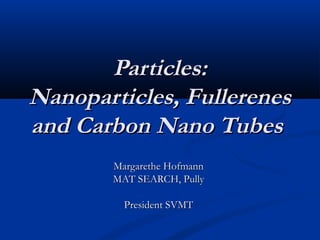

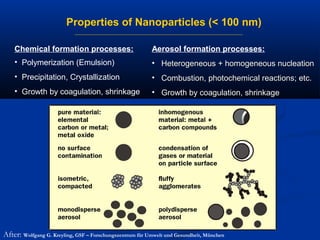
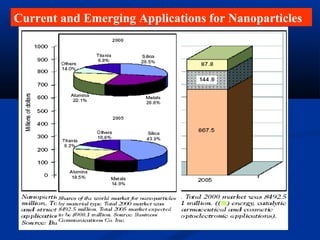
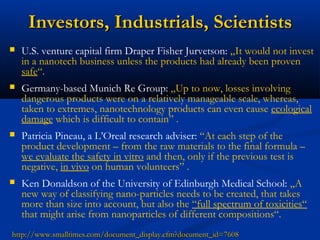
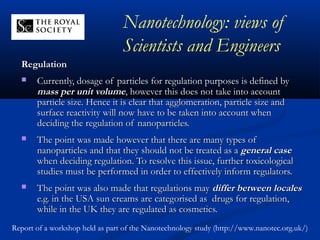

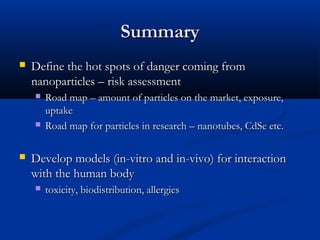
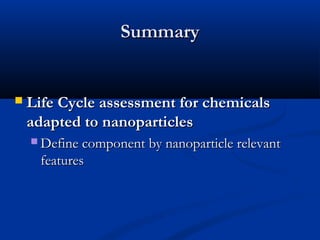
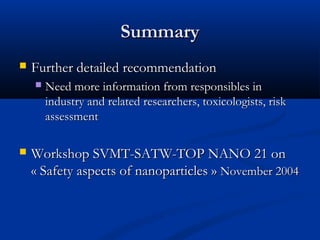
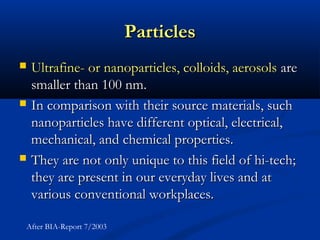


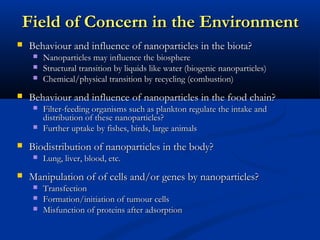
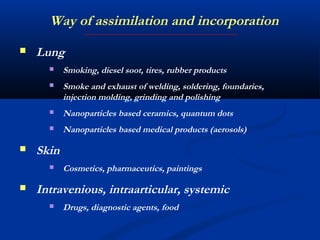

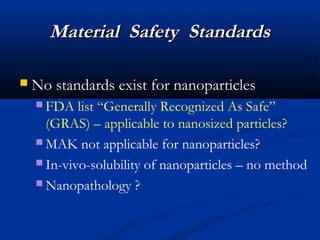

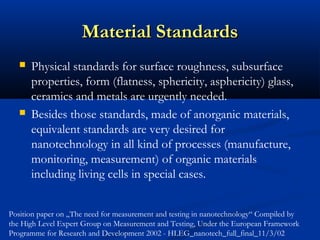
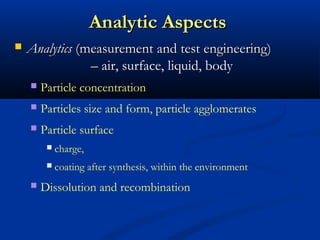
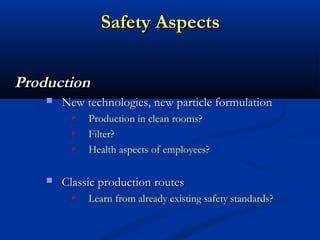
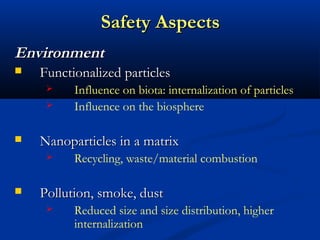



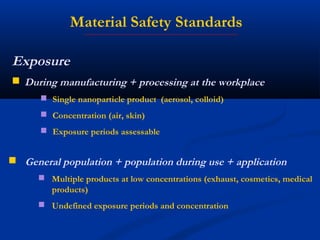
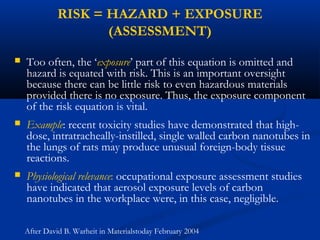
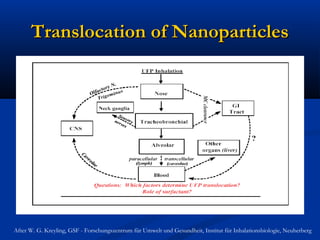

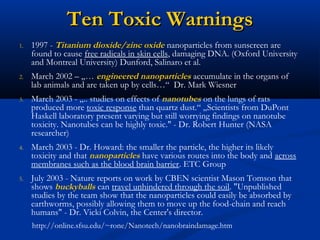
![Ten Toxic WarningsTen Toxic Warnings
6. January 2004 - Dr. G├╝nter Oberd├Ârster: nanoparticles are able to move easily
from the nasal passageway to the brain.
7. January 2004 - Nanosafety researchers from University of Leuven, Belgium in
Nature: nanoparticles will require new toxicity tests: "We consider that
producers of nanomaterials have a duty to provide relevant toxicity test results
for any new material, according to prevailing international guidelines on risk
assessment. Peter H. M. Hoet, Abderrrahim Nemmar and Benoit Nemery,
University of Belgium(14)
8. January 2004 - Nanotox 2004: Dr. Vyvyan Howard presents initial findings that
gold nanoparticles can move across the placenta from mother to fetus.
9. February 2004 - Scientists at University of California, San Diego discover that
cadmium selenide nanoparticles (quantum dots) can break down in the
human body potentially causing cadmium poisoning. "This is probably
something the [research] community doesn't want to hear." - Mike Sailor, UC
San Diego.(16)
10. March 2004 - Dr. Eva Oberd├Ârster: buckyballs (fullerenes) cause brain
damage in juvenile fish along with changes in gene function. "Given the rapid
onset of brain damage, it is important to further test and assess the risks and
benefits of this new technology before use becomes even more widespread." -
Dr. Eva Oberd├Ârster.
http://online.sfsu.edu/~rone/Nanotech/nanobraindamage.htm](https://image.slidesharecdn.com/nanotechnologymhofmann-140805110409-phpapp01/85/Nanotechnology-m-hofmann-31-320.jpg)
